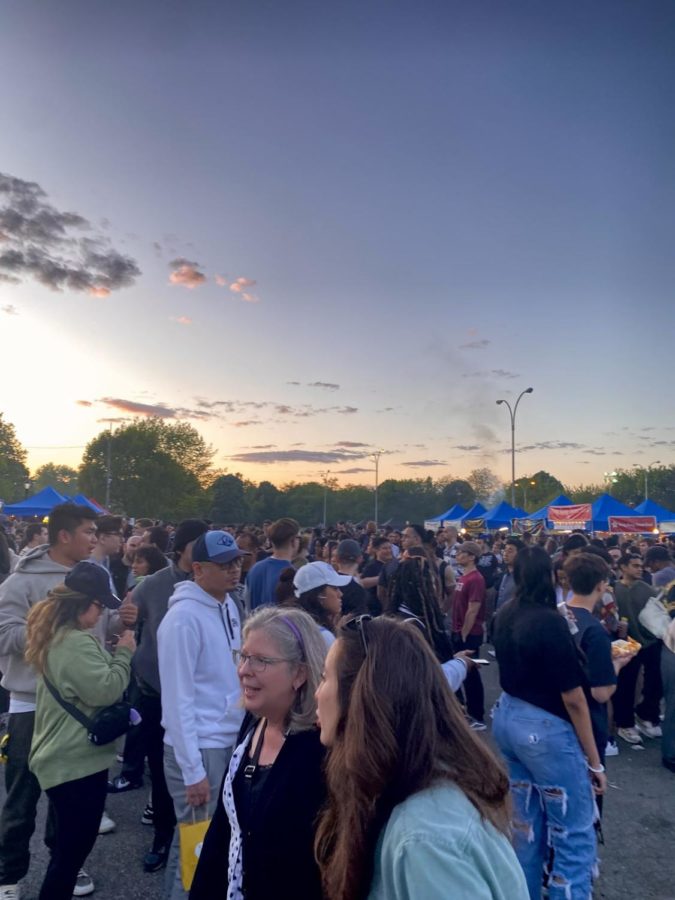The Worlds Within a Market: Stories of the Queens Night Market
A look into the exciting atmosphere of the Queens Night Market, and the people who make it what it is.
Even as the sun begins to set, the Queens Night Market is still only just ramping up to full swing for the night. The energy is electric, and the community seems to spring to life.
You take a step forward, towards the ever-enticing smells wafting your way, and suddenly you’re on the northern coast of Jamaica. A few steps to the right, and you are amongst the grand mountains of Tibet. Pedaling a few steps backwards, you are soon immersed in the humid city streets of Hong Kong.
But, you cannot walk on water across the Atlantic: you are not the Flash. Rather, you have just found yourself amid the 2 million other visitors who have explored the Queens Night Market over the course of its eight year run.
Night markets have long existed as early as the medieval Chinese Tang Dynasty in 800 A.D. During the rule of the Song Dynasty just a few centuries later, night markets became even more integrated into Chinese nightlife culture, as well as an essential place for the gathering of merchants and villagers (especially along important regions such as rivers or near temples). Nonetheless, the Queens Night Market revitalizes this long-standing history in New York City and has a novelty to be honored on its own as it pursues diversity and accessibility in ways New York has seen almost never before.
After its beginning in Flushing Meadows Corona Park in April 2015, the Queens Night Market has run every year since (with the exception of 2020 due to the COVID-19 pandemic). The market takes place on Saturday evenings from late April to late August, and then again from mid-September through late October. Welcoming vendors and visitors from all across New York City to find common ground in Queens, the night market is surrounded by delicious foods and a fascinating environment. As of 2019, around 10,000 people flock to the market every Saturday night.
The man behind the curtain of it all is none other than the ambitious Taiwanese-American foodie and former lawyer, John Wang, who has devoted hour after hour to organizing this event.
“My first exposure to night markets was as a kid in Taiwan, when I would go every summer. It was my grandparents who took me to my first night market, and ever since, it was all I wanted to do when we visited. It was safe and diverse, and there was something very electric about it — something very fun, and something very casual. They always felt very magical to me, and I wanted to recreate that in New York City,” Wang said in an interview.
But the most notable aspect of the market isn’t just its timeliness or popularity. Instead, it’s the sheer level of cultural diversity that flourishes at each opening of the market. Each year, the Queens Night Market showcases its diverse, ever-growing number of vendors, representing over 90 different countries over the course of the market’s run. Above all else, the heart of this event lies in it being a place for everyone.
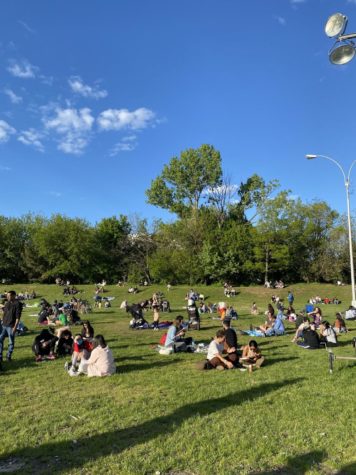
“[I]n making it as accessible as possible, I hope people feel like they’re in a place in New York City that they can afford and be a part of, no matter what,” said Wang. “I hope people soak in the diverse spaces, and it looks like all of New York City at Queens Night Market. You can sit down right next to a stranger and ask, ‘Where are you from? What are you eating? How are you doing tonight?’ and just seamlessly bridge that gap.”
It’s more than evident already that Queens Night Market is a celebration of community, a community brought together, not necessarily by background or prior relation, but rather, one cultivated with cultures as mixed as you can get. Who better to represent this medley of people than those who spend their Saturdays there, breathing life into the market?
On any given night, more than 60 different vendors bring all kinds of dishes, snacks, desserts, and finger food alike to the market. In preparation of this event each weekend, vendors carry with them not just ingredients, but their own stories as well. Unique stories from all corners of the globe are housed at the Queens Night Market, with themes of familial love, inspiration, childhood, tradition, and so much more. “The special thing with a lot of our vendors is that their entire life is sort of affiliated with that recipe or that dish that they cook up. The focus on tradition is really about connecting and creating a mesh of intergenerational stories,” said Wang.
Although lengthy conversations with vendors were limited due to the large lines, in early May 2023, I did have a chance to chat with a few of the talented people serving up tasty recipes at the market’s last sneak peek weekend before the public opening.
As soon as I stepped towards the Matylda’s Foods stand, I was greeted with warm smiles and friendly faces. There, underneath the large banner that read “DELICIOUS POLISH PIEROGI,” I was able to speak with Adam, who explained what we really mean when we say that ‘food is the way to the heart.’
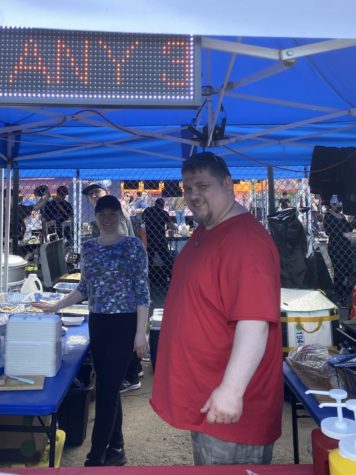
Pierogi, or filled dumplings made of unleavened dough, are perhaps the most quintessential item of Polish cuisine. They come in a wide range of fillings from sweet to savory, with sauerkraut and mushroom being the most prized choice.
“We have a few kinds of pierogi here, all authentic Polish flavors,” he said, gesturing towards the dough being meticulously prepared behind him. “These are the sorts of food that feel like a taste of home. Like this sauerkraut and mushroom pierogi here, especially; it always tastes the same across Poland, no matter who makes it or where you go. It’s incredibly comforting!”
“These pierogi are eaten basically non-stop, all year round, any holiday we get the chance. But mostly, they remind me of the feeling of gathering to eat them around Christmas and Christmas Eve.”
Despite first becoming a vendor at Queens Night Market just last year, Matylda’s Foods hopes to share a culture of traditions that has existed long since then. In Polish culture, pierogi are said to have originated in the 13th century, from the actual patron saint of pierogi, St. Hyacinth. Following his life as a Polish-Dominican Catholic priest and missionary (1185-1257), his life story became riddled with fascinating legends, some of which are attributed to the creation of pierogi.
In one story, St. Hyacinth is said to have visited the Southern Polish town of Kościelec, just as the people were experiencing a debilitating storm that had rid them of all viable crops. At the brink of starvation, the people turned to the priest for guidance, to which he prayed alongside them for a miracle. Miraculously, the crops were resurrected. As a token of their thanks to St. Hyacinth, the villagers dished him up a feast of pierogi made from those very crops.
Since, the old-time phrase “Święty Jacku z pierogami!” (“St. Hyacinth and his pierogi!”) was born as an exclamation for help and a sort of Polish equivalent of the English “Good grief!” More importantly, pierogi have become a beloved comfort food, with 31 million of them being eaten annually in the U.S. alone.
Beyond their mouth-watering taste, the significance of pierogi goes straight to the history they bring with them today, at places just like the Queens Night Market. For Adam and the rest of the team at Matylda’s Foods, the foods of their heritage are a reminder that there’s a place for you somewhere and everywhere, even if that place is simply a stand where you can take a bite into a hot pierogi.
As I smiled and waved goodbye after my fascinating stop at just one of the vendors at the market that night, the night drew on, and more and more visitors began to amass. Weaving my way through the crowds, I was struck by the sheer number and diversity of people standing in line, spreading picnic blankets, sitting on the outdoor tables, and most of all, smiling and laughing. This feeling of wonder was not brought on by just the market’s statistics or the numbers in any of the research articles I read in preparation for my visit. Rather it was the pure humanity that I witnessed as I walked by.
Nevertheless, the Queens Night Market we have come to love was not always a set success. John Wang explained,“I was actually convinced that it would be a total failure. I mean before this, I was a lawyer, and so I only gave myself a year to see if this whole thing would be a success. I was totally ready to finish that year and just see it fail, like so many other endeavors in New York. But then came the day that we opened for the first time – that was really the first day I was convinced. Seeing everyone show up, it just proved that there was this huge demand for it in New York City, and maybe it would work after all.”
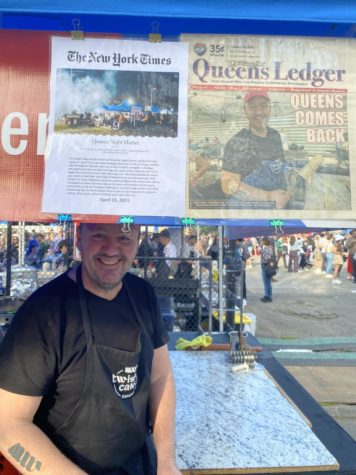
Finally, having made my way across the expanse at the center of the market, I was next drawn to the stall of Twister Cake. When I asked to hear a little bit about the business and its authenticity, the personality of its founder, Radu Sirbu, immediately shined through. “Well, this is Twister Cake, and we’re bringing to Queens Night Market Transylvanian cuisine, food from Romania. In terms of authenticity, it’s only been in my family for 200 years!”
As the name suggests, these “twister” cakes are made from sweet dough, coiled into a cylindrical shape, then baked and rolled in sugar to caramelize. Traditionally, they are known as Kürtöskalács, hailing from Radu’s own hometown of Transylvania, the beautifully gothic region in the Northwest of Romania. The sugary cakes date back as early as the 15th century from Hungarian-Romanian peoples living in the Székely Land area of Transylvania.
Similar to the pierogi, a heroic tale also accompanies Kürtöskalács. According to 19th century writers, during a Mongolian invasion of the Székely Land in 1241, these chimney cakes lifted the villagers to victory. As the Mongols pillaged the region, Romanian villagers in the nearby town of Máréfalva ran to a cave for safety. Unable to breach past the cave’s entrance, the invaders instead decided to wait the villagers out, expecting them to starve or surrender. However, those hiding in the cave quickly became aware that the Mongol army themselves had limited resources, and could also not afford to wait forever. With this in mind, the women of the group devised a plan of genius.
Using what little flour they had left, along with water and cave ash, they made a batch of dough, and rolled it around a huge pole to bake. Having formed the first ever Kürtöskalács, the women held it out within sight of their invaders outside the cave, taunting them with their supposed abundance of food, while the army stood unaware of the hollow interior of the cake. Believing that the villagers were still prospering inside while they began to starve outside, the Mongols had no choice but to pack up camp and let the townspeople be.
Kürtöskalács is now rightfully touted as the oldest Hungarian pastry, and it remains a staple of Hungarian and Romanian cuisine today. In fact, the record for the longest ever Kürtöskalács was broken at the Oroszfalu (Rusu de Sus) Village Fest in Transylvania, during which a single chimney cake of a whopping 16.7 meters – roughly 54.8 feet – was baked.
Demonstrating yet again the hodgepodge of different experiences celebrated at the market, unlike Matylda’s Foods, Twister Cake has been a vendor “since day 1!” said Radu. Yet like many, this founder’s connection with food stemmed from his connection to his family. “I have always loved cooking and baking, but mainly, I was inspired by my grandmother. She was the one who taught me all about it, and it’s still her recipes that we use in our baked goods today,” he said.
As I continued to inquire about how it felt for Radu to be at the Queens Night Market sharing his culture, his instantaneous response was, “Look, I have goosebumps! But yeah, it feels absolutely awesome to be able to give people a taste of Transylvania.”
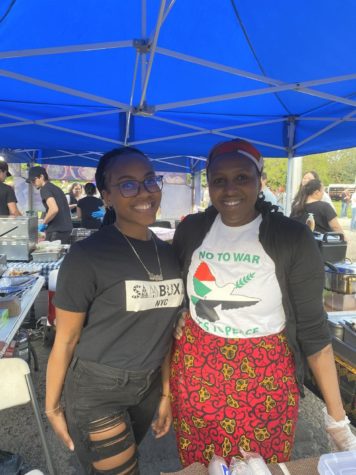
My final stop was Sambuxa NYC. There, business owner Gladys Shahtou prepared traditional Sudanese sambuxas with the help of Keera who was also working the stall that night. “All these recipes are ones my mom taught me to cook,” said Gladys. “In fact, my mom used to teach cooking lessons, which was really my first inspiration that started my love for cooking, and what brought me here to the creation of this business.”
As a whole, Sudanese cuisine is, in every respect, fascinating and diverse, and Sambuxa NYC makes it their mission to teach newcomers a little more about it. Influence from across the Middle East, the Mediterranean, and throughout the African continent all blend together to forge this rich culture of dishes. “The salata aswad (eggplant salad) is very authentic, as well as the feta cheese sambuxas and the scallion tomato salads.”
Many of the recipes passed down to Gladys from her mother compile together the business’ eponymous dish – their sambuxas. Similarly known also as samosas or sambusas, the tasty side dish is carefully crafted from fried pastry dough and filled with a world of ingredients (most popularly, onions, peas, potato, meat, and fish.)
In ancient times of the Middle East, sambuxa were solely relegated as a luxury delicacy for royal families. In fact, even the inspiration for the now-street snack was equally grand. The first sambuxa were known as samsa, shaped in their recognizable triangular shape as a homage to the great Egyptian pyramids. Thankfully, this exclusivity didn’t stay that way. As the Sambuxa NYC website explains, sambuxas are nowadays “served when guests visit (meaning constantly) or at weddings and holiday celebrations.” Sambuxa stand as a warm hug of companionship and open door, welcoming you in.
“It’s definitely an amazing experience being here at the market because, you know, there’s not a lot of Sudanese restaurants in New York,” said Gladys. “Not a lot of people know about Sudanese food as a whole, and it’s really great to be the ones to let them experience that!” Keera said.
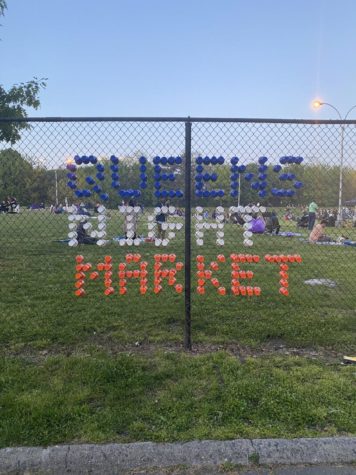
Undoubtedly, Queens Night Market is a cheerful destination for affordable eats on warm weekend nights. But what’s more, the market is a physical symbol of courage, pride, generosity, and curiosity. The blue tents and large crowds embody these values like no other: the courage needed to quit your job, to take a chance, and to bring something new to the table. They also represent the pride to share the culture you hold dear, and the generosity to touch the hearts of others with it, along with the human curiosity to dip your toes into the unknown waters, to live a little, and to learn a lot.
Despite the clear and amazing diversity of New York City, in a city as bustling as this, it’s easy to blow past what is unfamiliar to us and overlook the surplus of culture right under our noses. But here in Flushing Meadows-Corona Park, on these summer Saturday nights, the Queens Night Market is a bright and welcoming sign urging you to stop for a moment and take everything in.
“The most rewarding thing to me is just the diversity of people who come to Queens Night Market. It was really about creating a space that felt like New York as a community. That’s probably the thing that makes me the happiest. I mean, running this event? It’s stressful! But the silver lining at the end of the day is looking out into the crowd and seeing how diverse and happy everyone is, coming from all different walks of life,” said Wang.
So at the end of the day, the story of the market isn’t just in the food; it is in each and every vendor, each and every visitor, and each and every person who will fill those roles in the time to come. They each have a lifetime of stories behind them, and lifetimes more awaiting them.
“The special thing with a lot of our vendors is that their entire life is sort of affiliated with that recipe or that dish that they cook up. The focus on tradition is really about connecting and creating a mesh of intergenerational stories,” said John Wang.
Sidney Lin is an Editor-in-Chief for ‘The Science Survey.’ Sidney cherishes the chance to edit her peers’ articles in all sections of the newspaper...

